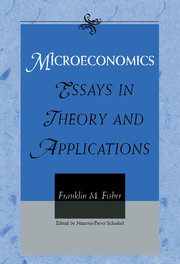Book contents
- Frontmatter
- Contents
- Introduction
- Part I Disequilibrium and Stability
- Part II Welfare Economics and Consumer Theory
- Part III Applications of Microeconomic Theory
- 19 On Donor Sovereignty and United Charities (1977)
- 20 A Proposal for the Distribution Abroad of the United States' Food Surplus (1962)
- 21 A Theoretical Analysis of the Impact of Food Surplus Disposal on Agricultural Production in Recipient Countries (1963)
- 22 US Experience: The Recent INS Study (1970)
- 23 Aspects of Cost-Benefit Analysis in Defence Manpower Planning (1969)
- Part IV Industrial Organization, Economics, and the Law
- Part V Public Policy Applications
- Epilogue
- Indexes
19 - On Donor Sovereignty and United Charities (1977)
Published online by Cambridge University Press: 20 March 2010
- Frontmatter
- Contents
- Introduction
- Part I Disequilibrium and Stability
- Part II Welfare Economics and Consumer Theory
- Part III Applications of Microeconomic Theory
- 19 On Donor Sovereignty and United Charities (1977)
- 20 A Proposal for the Distribution Abroad of the United States' Food Surplus (1962)
- 21 A Theoretical Analysis of the Impact of Food Surplus Disposal on Agricultural Production in Recipient Countries (1963)
- 22 US Experience: The Recent INS Study (1970)
- 23 Aspects of Cost-Benefit Analysis in Defence Manpower Planning (1969)
- Part IV Industrial Organization, Economics, and the Law
- Part V Public Policy Applications
- Epilogue
- Indexes
Summary
There are eight degrees in alms-giving, one lower than the other…. [The second degree] is giving alms in such a way that the giver and recipient are unknown to each other…. [One way to accomplish this is by] the donation of money to the charity fund of the Community, to which no contribution should be made unless there is confidence that the administration is honest, prudent, and efficient.
Below this degree is the instance where the donor is aware to whom he is giving the alms, but the recipient is unaware from whom he received them. The great Sages, for example, used to go about secretly throwing money through the doors of the poor. This is quite a proper course to adopt and a great virtue where the administrators of a charity fund are not acting fairly.
MaimonidesThe Problem
It is common practice for individual charitable organizations to merge their fund raising activities. The United Fund or Community Chest, the United Jewish Appeal, and Federation of Jewish Philanthropies are wellknown examples. There are obvious reasons for such mergers. By having a common fund drive, the combined organizations save considerable expenditure of resources that would otherwise be largely duplicative; moreover, prospective donors are saved the annoyance of having more than one solicitor call. For both reasons, the net receipts of the combined charities may well go up.
On the other hand, such charitable combinations impose a hidden cost on their donors. Whereas before the merger a donor could control the separate amounts that he gave to each charity, after the merger he can generally control only the total amount of his gift.
- Type
- Chapter
- Information
- MicroeconomicsEssays in Theory and Applications, pp. 275 - 285Publisher: Cambridge University PressPrint publication year: 1999



